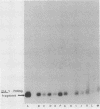Abstract
The hemolytic activity of toxic shock syndrome isolates of Staphylococcus aureus is enhanced when agarose is substituted for agar in blood plates or when strains are grown in liquid culture in the presence of 20% (vol/vol) CO2 in air. Hemolytic activity of a representative panel of toxic shock syndrome isolates was rigorously assessed both on blood agar and in liquid culture to unequivocally identify the predominant hemolysins produced. As determined by isoelectric focusing and Western immunoblotting, 15 of 15 TSS isolates produced gamma-lysin and 10 of 15 produced delta-lysin. None produced beta-lysin, and only 2 of 15 produced alpha-lysin. The low rate of alpha-lysin production was a most striking characteristic, since all strains were found to have the alpha-lysin gene by Southern blot hybridization.
Full text
PDF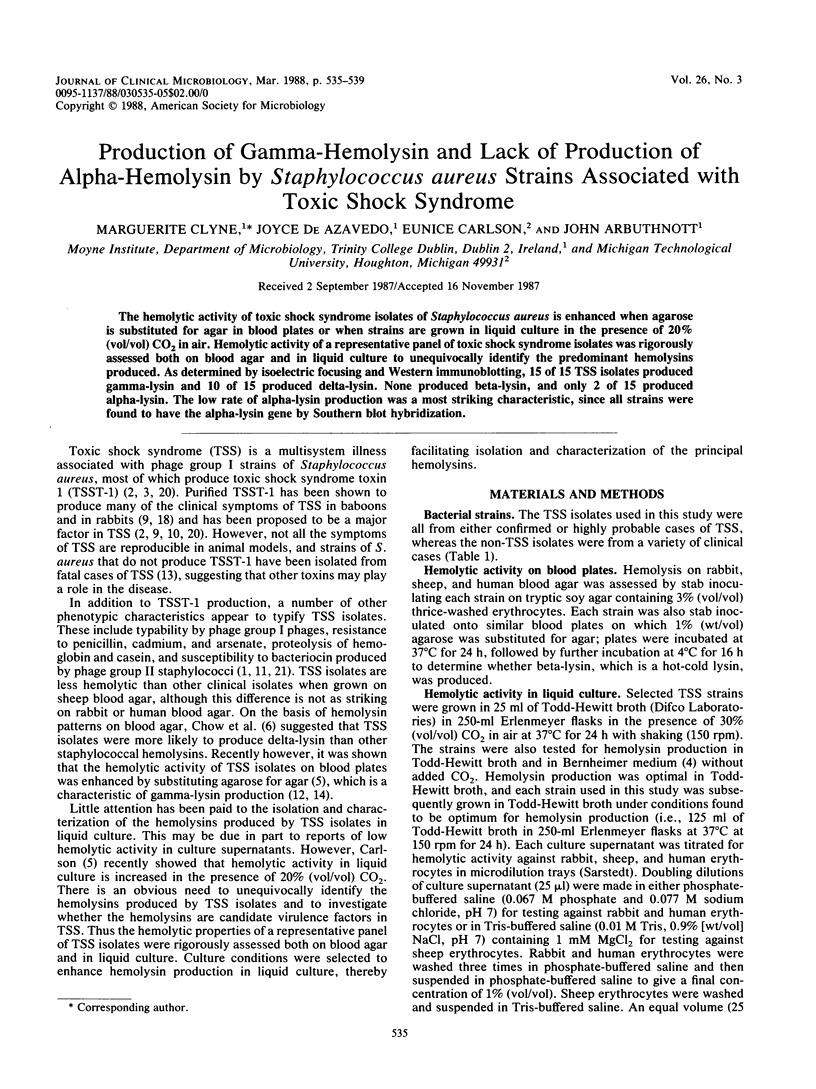
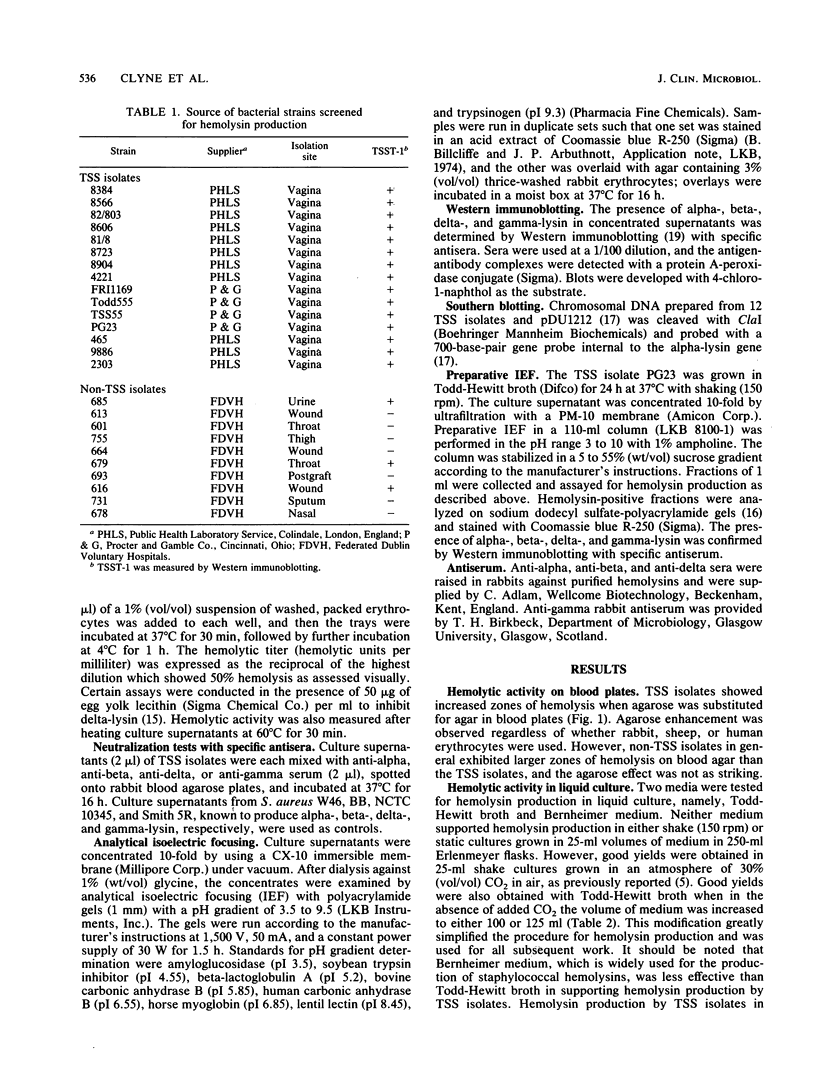
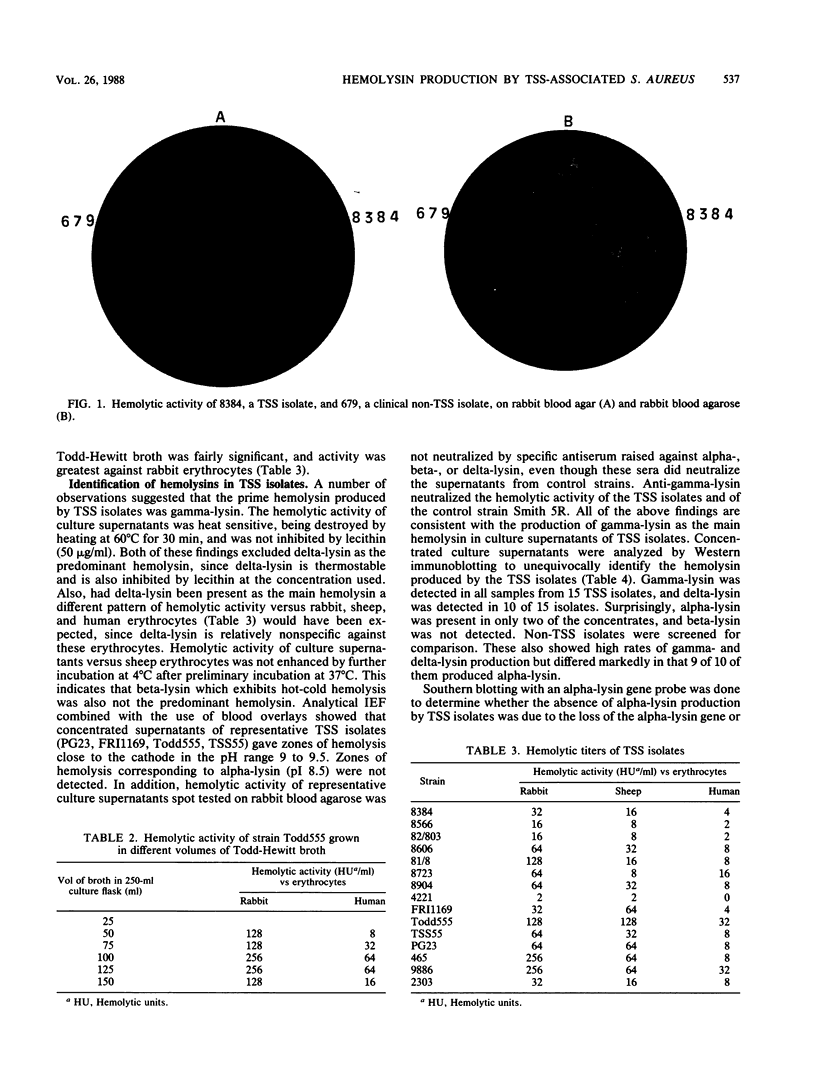
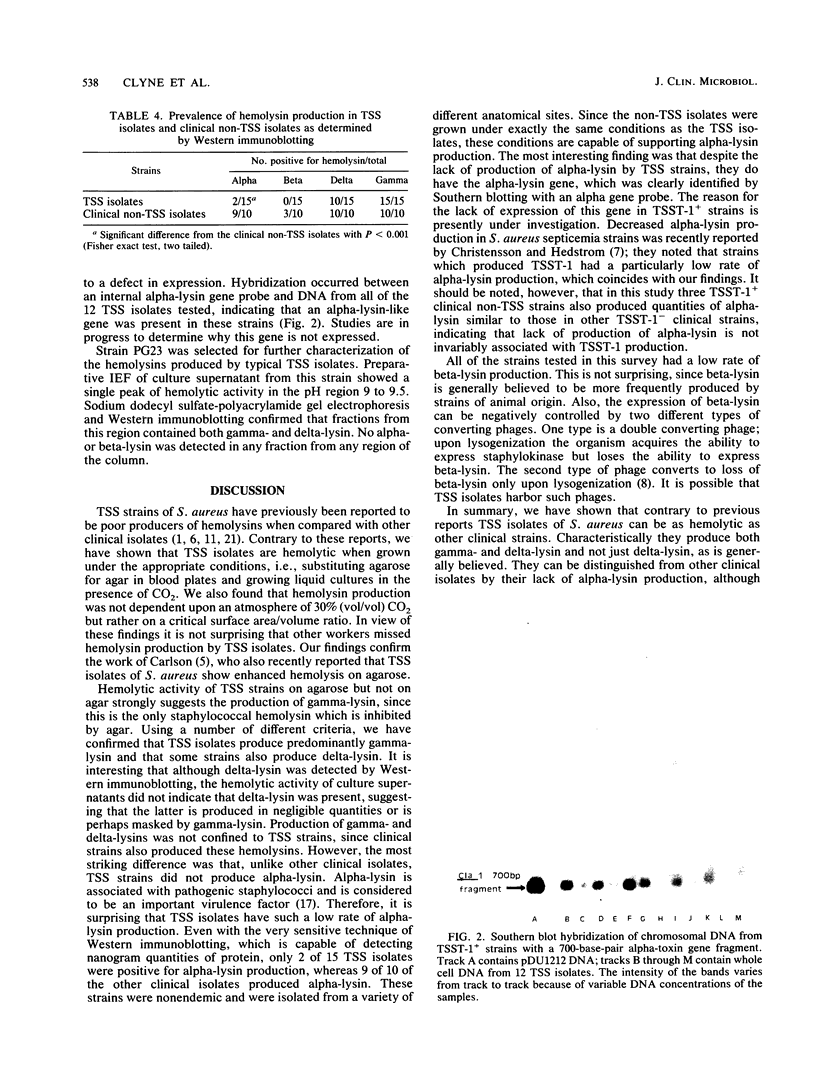
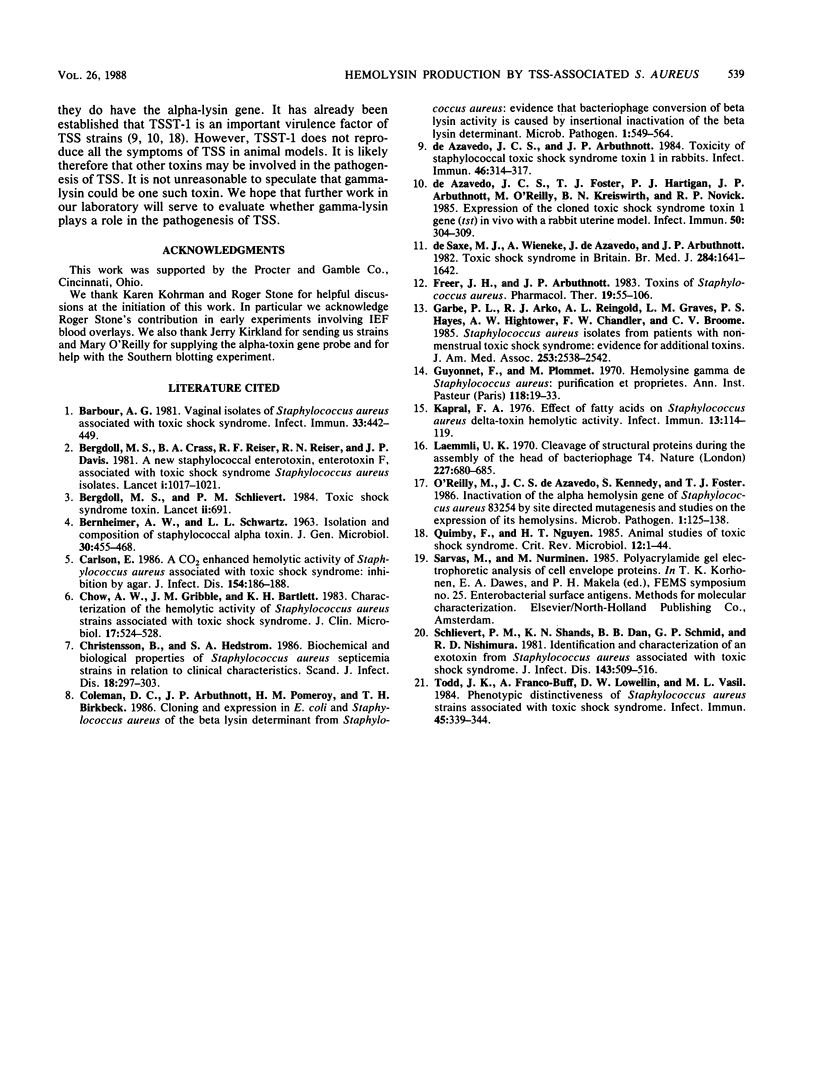
Images in this article
Selected References
These references are in PubMed. This may not be the complete list of references from this article.
- BERNHEIMER A. W., SCHWARTZ L. L. Isolation and composition of staphylococcal alpha toxin. J Gen Microbiol. 1963 Mar;30:455–468. doi: 10.1099/00221287-30-3-455. [DOI] [PubMed] [Google Scholar]
- Barbour A. G. Vaginal isolates of Staphylococcus aureus associated with toxic shock syndrome. Infect Immun. 1981 Aug;33(2):442–449. doi: 10.1128/iai.33.2.442-449.1981. [DOI] [PMC free article] [PubMed] [Google Scholar]
- Bergdoll M. S., Crass B. A., Reiser R. F., Robbins R. N., Davis J. P. A new staphylococcal enterotoxin, enterotoxin F, associated with toxic-shock-syndrome Staphylococcus aureus isolates. Lancet. 1981 May 9;1(8228):1017–1021. doi: 10.1016/s0140-6736(81)92186-3. [DOI] [PubMed] [Google Scholar]
- Carlson E. C. A CO2-enhanced hemolytic activity of Staphylococcus aureus associated with toxic shock syndrome: inhibition by agar. J Infect Dis. 1986 Jul;154(1):186–188. doi: 10.1093/infdis/154.1.186. [DOI] [PubMed] [Google Scholar]
- Chow A. W., Gribble M. J., Bartlett K. H. Characterization of the hemolytic activity of Staphylococcus aureus strains associated with toxic shock syndrome. J Clin Microbiol. 1983 Mar;17(3):524–528. doi: 10.1128/jcm.17.3.524-528.1983. [DOI] [PMC free article] [PubMed] [Google Scholar]
- Christensson B., Hedström S. A. Biochemical and biological properties of Staphylococcus aureus septicemia strains in relation to clinical characteristics. Scand J Infect Dis. 1986;18(4):297–303. doi: 10.3109/00365548609032340. [DOI] [PubMed] [Google Scholar]
- Coleman D. C., Arbuthnott J. P., Pomeroy H. M., Birkbeck T. H. Cloning and expression in Escherichia coli and Staphylococcus aureus of the beta-lysin determinant from Staphylococcus aureus: evidence that bacteriophage conversion of beta-lysin activity is caused by insertional inactivation of the beta-lysin determinant. Microb Pathog. 1986 Dec;1(6):549–564. doi: 10.1016/0882-4010(86)90040-9. [DOI] [PubMed] [Google Scholar]
- Freer J. H., Arbuthnott J. P. Toxins of Staphylococcus aureus. Pharmacol Ther. 1982;19(1):55–106. doi: 10.1016/0163-7258(82)90042-0. [DOI] [PubMed] [Google Scholar]
- Garbe P. L., Arko R. J., Reingold A. L., Graves L. M., Hayes P. S., Hightower A. W., Chandler F. W., Broome C. V. Staphylococcus aureus isolates from patients with nonmenstrual toxic shock syndrome. Evidence for additional toxins. JAMA. 1985 May 3;253(17):2538–2542. [PubMed] [Google Scholar]
- Guyonnet F., Plommet M. Hémolysine gamma de staphylococcus aureus: purification et propriétés. Ann Inst Pasteur (Paris) 1970 Jan;118(1):19–33. [PubMed] [Google Scholar]
- Kapral F. A. Effect of fatty acids on Staphylococcus aureus delta-toxin hemolytic activity. Infect Immun. 1976 Jan;13(1):114–119. doi: 10.1128/iai.13.1.114-119.1976. [DOI] [PMC free article] [PubMed] [Google Scholar]
- Laemmli U. K. Cleavage of structural proteins during the assembly of the head of bacteriophage T4. Nature. 1970 Aug 15;227(5259):680–685. doi: 10.1038/227680a0. [DOI] [PubMed] [Google Scholar]
- O'Reilly M., de Azavedo J. C., Kennedy S., Foster T. J. Inactivation of the alpha-haemolysin gene of Staphylococcus aureus 8325-4 by site-directed mutagenesis and studies on the expression of its haemolysins. Microb Pathog. 1986 Apr;1(2):125–138. doi: 10.1016/0882-4010(86)90015-x. [DOI] [PubMed] [Google Scholar]
- Quimby F., Nguyen H. T. Animal studies of toxic shock syndrome. Crit Rev Microbiol. 1985;12(1):1–44. doi: 10.3109/10408418509104424. [DOI] [PubMed] [Google Scholar]
- Schlievert P. M., Shands K. N., Dan B. B., Schmid G. P., Nishimura R. D. Identification and characterization of an exotoxin from Staphylococcus aureus associated with toxic-shock syndrome. J Infect Dis. 1981 Apr;143(4):509–516. doi: 10.1093/infdis/143.4.509. [DOI] [PubMed] [Google Scholar]
- Todd J. K., Franco-Buff A., Lawellin D. W., Vasil M. L. Phenotypic distinctiveness of Staphylococcus aureus strains associated with toxic shock syndrome. Infect Immun. 1984 Aug;45(2):339–344. doi: 10.1128/iai.45.2.339-344.1984. [DOI] [PMC free article] [PubMed] [Google Scholar]
- de Azavedo J. C., Arbuthnott J. P. Toxicity of staphylococcal toxic shock syndrome toxin 1 in rabbits. Infect Immun. 1984 Nov;46(2):314–317. doi: 10.1128/iai.46.2.314-317.1984. [DOI] [PMC free article] [PubMed] [Google Scholar]
- de Azavedo J. C., Foster T. J., Hartigan P. J., Arbuthnott J. P., O'Reilly M., Kreiswirth B. N., Novick R. P. Expression of the cloned toxic shock syndrome toxin 1 gene (tst) in vivo with a rabbit uterine model. Infect Immun. 1985 Oct;50(1):304–309. doi: 10.1128/iai.50.1.304-309.1985. [DOI] [PMC free article] [PubMed] [Google Scholar]
- de Saxe M. J., Wieneke A., de Asavedo J., Arbuthnott J. P. Toxic shock syndrome in Britain. Br Med J (Clin Res Ed) 1982 May 29;284(6329):1641–1642. [PMC free article] [PubMed] [Google Scholar]




